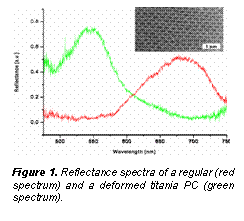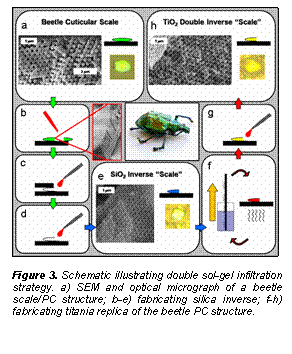

46482-G10
Utilizing Photonic Band Structure Engineering for Advanced Photon Management in Solar Energy Conversion
Activities
The defining objective is to develop low-cost and simple strategies for the fabrication of photonic crystals (PCs) with a complete photonic band gap (PBG) in the visible and study their potential for efficient solar energy conversion. Our approach combines fabrication, structural and optical characterization, and theoretical modeling to steadily optimize the influence of photonic band structure engineering on the optical and optoelectronic properties. The funding from this PRF grant enabled us to make significant progress in three main areas:
1) Structural and optical characterization of natural 3D PCs.
2) Using bio-templating to convert biological PCs into technologically important materials.
3) Spectroscopic studies and theoretical photonic band structure calculations.
Findings
Among the various 3D PC structures, diamond-based morphologies are the clear “champions” in terms of their ability to create a complete PBG. Complete PBG materials would enable efficient non-classical manipulation of light and thus promise enormous potential for next-generation energy and information technology. However, to date, a complete PBG material operating in the visible has not been realized – mostly due to our inability to “shape” transparent high-dielectric materials into appropriate 3D periodic nanostructures at these length scales. While self-assembly of submicrometer spheres is the method of choice to create PCs with periodicities at visible wavelengths, the natural tendency of the spherical building blocks to form densely
|
 packed highly-symmetric opal-like
crystals prevents their self-assembly into non-close-packed diamond-based
lattice morphologies. Initial efforts of our research were therefore directed
towards post-assembly symmetry-breaking methods. For this, we subjected
opal-like PCs to a heat/pressure treatment in order to induce controlled
deformation of the symmetric building blocks along selective crystal axes. The
deformed colloidal crystals were then transformed into high-refractive index
titania inverse structures and their properties were determined by SEM imaging,
optical spectroscopy and theoretical band structure calculations. As shown in
Figure 1, this method enables successful fabrication of symmetry-broken PCs
(e.g., brickwall-type structures) with significantly modified photonic
properties. However, we also found severe limitations of this method in terms
of degree and uniformity of deformation and defect density.
packed highly-symmetric opal-like
crystals prevents their self-assembly into non-close-packed diamond-based
lattice morphologies. Initial efforts of our research were therefore directed
towards post-assembly symmetry-breaking methods. For this, we subjected
opal-like PCs to a heat/pressure treatment in order to induce controlled
deformation of the symmetric building blocks along selective crystal axes. The
deformed colloidal crystals were then transformed into high-refractive index
titania inverse structures and their properties were determined by SEM imaging,
optical spectroscopy and theoretical band structure calculations. As shown in
Figure 1, this method enables successful fabrication of symmetry-broken PCs
(e.g., brickwall-type structures) with significantly modified photonic
properties. However, we also found severe limitations of this method in terms
of degree and uniformity of deformation and defect density.Due to the severe engineering limitations of synthetic PCs operating in the visible, we turned our attention to natural photonic structures found in iridescent
|
 insects. These biological systems
have developed a wealth of photonic structures optimized to strongly interact
with visible light. In particular, the striking iridescent coloration of many
beetle species is the result of various types of elaborate 3D PC morphologies.
In order to take full advantage of the structures provided by nature and to
determine their photonic properties we developed a 3D structure analysis
technique. Using sequential focused ion beam milling combined with SEM imaging
and volume rendering techniques we are able to evaluate and reconstruct
biological PCs with unprecedented resolution. Surprisingly, we found that
certain beetles obtain their striking iridescence from cuticular PCs with a diamond-based
lattice morphology – the champion of photonic structures! One example is the
Brazilian weevil Lamprocyphus augustus
shown in Figure 2.
insects. These biological systems
have developed a wealth of photonic structures optimized to strongly interact
with visible light. In particular, the striking iridescent coloration of many
beetle species is the result of various types of elaborate 3D PC morphologies.
In order to take full advantage of the structures provided by nature and to
determine their photonic properties we developed a 3D structure analysis
technique. Using sequential focused ion beam milling combined with SEM imaging
and volume rendering techniques we are able to evaluate and reconstruct
biological PCs with unprecedented resolution. Surprisingly, we found that
certain beetles obtain their striking iridescence from cuticular PCs with a diamond-based
lattice morphology – the champion of photonic structures! One example is the
Brazilian weevil Lamprocyphus augustus
shown in Figure 2.Following this discovery we developed a materials chemistry route to convert these biological structures into a technologically-relevant semiconductor material.
|
 Such a conversion is necessary, since
the original beetle structure is made out of a chitin-based material, which
does not possess a high enough refractive index and is not semiconducting –
both are necessary requirements for efficient use in optical and optoelectronic
applications. The main steps of this technique are shown in Figure 3. Here, a
silica inverse of the original beetle structure is created first by sol-gel
chemistry, which subsequently serves as a removable template for fabricating an
exact replica of the beetle diamond structure out of the high refractive index
semiconductor titania. Current studies focus on fully characterizing the
bio-templated titania PCs and to assess their potential for solar energy
conversion.
Such a conversion is necessary, since
the original beetle structure is made out of a chitin-based material, which
does not possess a high enough refractive index and is not semiconducting –
both are necessary requirements for efficient use in optical and optoelectronic
applications. The main steps of this technique are shown in Figure 3. Here, a
silica inverse of the original beetle structure is created first by sol-gel
chemistry, which subsequently serves as a removable template for fabricating an
exact replica of the beetle diamond structure out of the high refractive index
semiconductor titania. Current studies focus on fully characterizing the
bio-templated titania PCs and to assess their potential for solar energy
conversion.Meanwhile, we also started to develop biomimetic-based directed assembly routes to synthetically fabricate PC structures found in nature. The strategy here is to study the assembly of chitosan building blocks in spatially confined environments in order to mimic the confined assembly space in beetle scales. The ultimate goal is to translate biological strategies into materials chemistry routes for the realization of synthetic, large-scale PCs for optimized conversion of solar photons into chemical fuel and/or electricity.